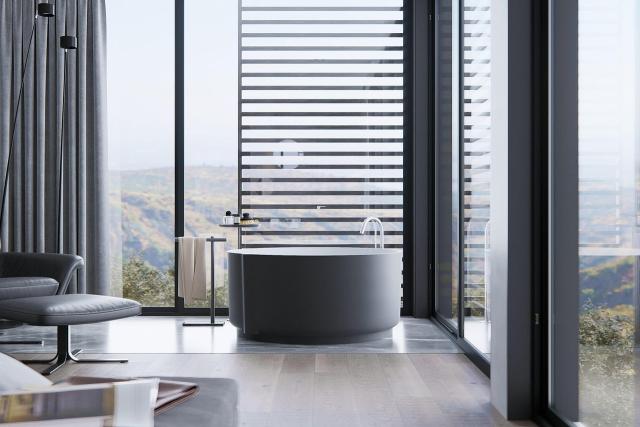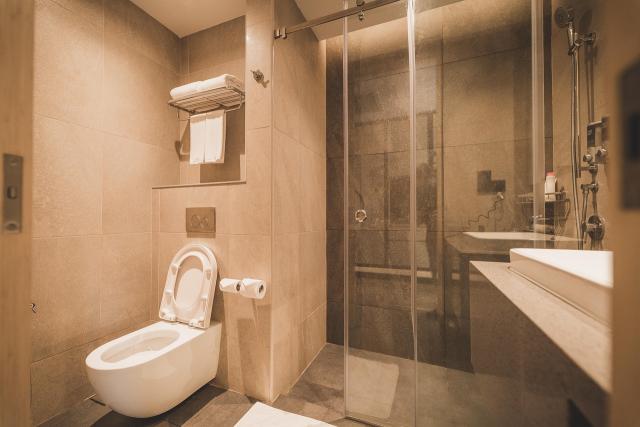
How to Install Ventilation in a Bathroom
Bathrooms are notorious for high humidity, which can lead to mold growth. Mold not only ruins the...

Bathrooms aren’t just practical spaces for daily routines—they’re where we unwind after a long day. But nothing ruins a relaxing soak like the sound of water dripping into the ceiling below. Proper bathroom waterproofing isn’t just a good idea; it’s essential.
Without it, you risk costly repairs, mold growth, and unhappy neighbors (especially in condos or townhomes). This guide walks you through everything you need to know to create a reliable, long‑lasting waterproof barrier under your tile or other finishes.
Protect Your Investment
Water damage can weaken floor joists, rot framing lumber, and delaminate wall sheathing. Repairing structural damage is expensive—often thousands of dollars.
Prevent Mold and Mildew
Even tiny leaks behind tile or under a shower pan can foster mold growth. Mold not only looks and smells unpleasant, it can trigger allergies and respiratory issues.
Maintain Good Relations in Multi‑Unit Buildings
If you live in an apartment, condo, or duplex, a leak can drip into your neighbor’s ceiling. That can mean conflict, lawsuits, and paying for damage you caused.
Comply with Building Codes
Many local building codes require specific waterproofing measures in wet areas. Failing an inspection can delay your remodel and cost time and money.
There are three main categories of waterproofing:
Sheet Membranes
– Examples: Schluter®-KERDI, Wedi–Board panels, NobleSeal®
– Pros: Factory‑controlled thickness, high reliability, vapor‑tight
– Cons: More expensive, tricky to seam around corners and penetrations
Liquid‑Applied Membranes
– Examples: Mapei Mapelastic, LATICRETE Hydro Ban, RedGard®
– Pros: Seamless coverage, easy brush or roller application, budget‑friendly
– Cons: Must achieve full thickness in two coats, requires careful attention to coverage
Cementitious Coatings (Penetrating Crystals)
– Examples: Penetron® Admix, Kryton Krystol Internal Membrane
– Pros: Chemically bonds with concrete, lasts the life of the slab
– Cons: Long cure times, not ideal for small cracks or field‑built curbs
Most DIYers and many professionals opt for liquid‑applied membranes because they strike the best balance between cost, ease of installation, and performance.
RedGard® Waterproofing and Crack Prevention Membrane
A popular elastomeric membrane that goes on pink and dries bright red for visual confirmation.
Schluter®-KERDI
A polyethylene sheet membrane that integrates with Schluter®-DITRA uncoupling underlayment.
LATICRETE Hydro Ban
A thin, quick‑drying liquid membrane that bonds to most substrates without primer.
Mapei Mapelastic AquaDefense
A ready‑to‑use, fast‑curing liquid membrane ideal for showers and tub surrounds.
Penetron® Concrete Waterproofing
A crystalline admixture that’s typically mixed into concrete or slurries.
Select Your Finish Material
Decide if you’ll use ceramic or porcelain tile, natural stone, vinyl plank, or paint. Your choice affects which waterproofing system is best.
Evaluate Substrate Condition
Concrete Slab: Check for cracks wider than 1/16″.
Wood Framing: Ensure the subfloor is sturdy (minimum ¾″ exterior‑grade plywood or equivalent cement board).
Existing Waterproofing: If you’re remodeling, remove old coatings and clean off adhesives.
Confirm Local Code Requirements
Some jurisdictions require a pre‑final inspection of waterproofing in showers or wet rooms. Get any necessary permits.
Gather Tools & Materials
– ½″ nap roller or brush for liquids
– Margin trowel or putty knife for mud or sealant
– Waterproofing membrane and accessories (corners, flashing tape)
– Backerboard (if needed), thin‑set mortar, tile
– Rubber gloves, respirator (for solvent‑based primers), drop cloths
Proper adhesion depends on a clean, sound substrate.
Remove Loose Debris and Dust
Vacuum or sweep the floor and walls thoroughly. Any grit can break the membrane seal.
Repair Cracks & Gaps
Under 1/16″: Fill with premixed patch or elastomeric sealant.
Over 1/16″: Use hydraulic‑setting patching mortar.
Prime the Surface (If Required)
Some liquid membranes (e.g., LATICRETE Hydro Ban in certain conditions) require a primer coat. Always follow manufacturer instructions.
Install Backerboard (If Needed)
If you’re tiling walls over studs, install cement backerboard with proper fasteners. Tape seams with alkali‑resistant mesh tape and a thin layer of thin‑set.
Leaks often start at inside corners, floor‑wall junctions, and around pipe penetrations.
Apply Waterproofing Tape or Preformed Membrane
Fold tape into the inside corner.
Press it firmly into the substrate using a roller or trowel.
Seal Pipe and Faucet Holes
Install rubber gaskets or collar seals around pipes.
For new construction, use split‑ring or compression seals that tighten against the subfloor.
Pre‑Coat Seams
Brush a thin bond coat of liquid membrane over tape edges to fully bond them to the floor or wall.
First Coat
Stir thoroughly before use.
Using a roller or brush, apply a uniform 30‑mil (0.75 mm) coat.
Work methodically so no area is missed.
Drying Time
Allow 1–2 hours at 70°F (21°C) and <50% relative humidity.
Cure times vary by product; check the label.
Second Coat
Apply perpendicular to the first coat to ensure full coverage.
Total thickness should meet product spec (often 60 mil or about 1.5 mm).
Inspect
Look for pinholes, thin spots, and uncoated areas.
Touch up as needed.
Thin‑Set Bed
Butter the substrate with thin‑set mortar using a notched trowel.
Lay the Membrane
Embed the sheet into the wet mortar, smoothing out wrinkles.
Maintain at least 2″ overlap at seams.
Seal Seams & Corners
Use KERDI‑BOARD preformed corners or waterproofing tape with thin‑set.
Weld or seal seams per manufacturer guidance.
Dry‑Fit Accessories
Install KERDI‑DRAIN or flange fixtures now, so tile work goes in last.
Before you install tile or other finishes, conduct a flood test:
Flood Test for Showers
Plug the shower drain and fill the pan with ½–1″ of water.
Let stand for 24 hours. Check adjoining areas below for leaks.
Inspect & Repair
Any sign of dampness means re‑sealing or adding more membrane in that area.
Once your waterproofing passes the flood test:
Choose the Right Thin‑Set
Use a polymer‑modified thin‑set mortar rated for wet applications.
Back‑butter Large Tiles
For tiles larger than 12″×12″, apply a skim coat on the tile back to ensure full coverage.
Maintain Proper Grout Joint Width
Typically 1/8″–3/16″. Use spacer clips if needed.
Grouting & Sealing
Use a grout suitable for wet areas (sanded or unsanded per joint size).
Seal grout lines after curing to limit moisture penetration.
Re‑Seal Grout Every 1–2 Years
Grout is porous; periodic sealing prolongs life.
Check Caulk Lines Annually
Replace any cracked or missing caulk around tub edges, faucets, or transitions.
Ventilate
Run your exhaust fan during and after showers to reduce humidity and prolong the life of waterproofing.
Skipping Surface Prep: Dirt, oil, or loose paint prevents proper bonding.
Uneven Application: Thin spots lead to leaks. Use a wet film gauge if in doubt.
Ignoring Manufacturer Specs: Dry times, temperatures, and coverage rates are all critical.
Rushing the Flood Test: It’s tempting to tile over a wet membrane—don’t do it.
Liquid Membrane Kit: $50–$150 for 5–10 gallons (covers ~50–100 sq. ft. per kit).
Sheet Membrane Rolls: $2–$5 per sq. ft., depending on brand.
Labor vs. DIY: Hiring a pro can double or triple material cost, but ensures warranty and code compliance.
For a standard 5′×3′ shower pan, expect to spend $200–$600 on materials alone. Larger floors or full‑bath surround waterproofing will, of course, cost more.
IBC/IRC, Section P2705 (USA):
Requires an impervious membrane under bonded tile in showers.
ANSI A118.10:
Standards for load‑bearing, waterproof membranes used in tile installations.
TCNA (Tile Council of North America) Handbook:
Defines methods, materials, and testing procedures for tile and waterproofing.
Always verify with your local code office, as municipalities may add stricter requirements.
Waterproofing your bathroom may seem daunting, but with careful planning, quality materials, and an eye for detail, you can install a leak‑proof system that lasts decades. Whether you choose a liquid membrane like RedGard®, a sheet system like Schluter®-KERDI, or a crystalline admixture for new concrete, following manufacturer instructions and best practices is key. A successful waterproofing job not only protects your home’s structure and your investment, but also ensures peace of mind every time you step into your shower or tub.

Thanks for joining our homeowners’ community.
Stay tuned!
Choose the category
Choose the category